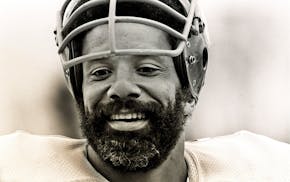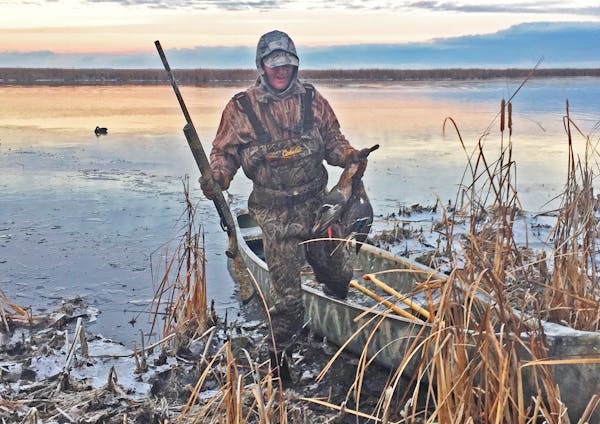Red Lake Nation tribal leaders in northern Minnesota say they are going to the U.S. Department of Interior with a longstanding grievance over boundary lines in an attempt to bring all of Upper Red Lake under their control.
It's far too early to tell if the strongly independent reservation can succeed in expanding its borders to include the eastern four-tenths of Upper Red Lake, where hundreds of thousands of state-licensed anglers fish for walleyes. But any sustained campaign by the Red Lake Band of Chippewa to restore tribal control over Upper Red Lake would become a blockbuster story for years to come in the Upper Midwest fishing world.
Al Pemberton, director of the Red Lake Department of Natural Resources, told the Star Tribune this week that lawyers recently took the tribe's concerns to Washington, D.C. He said deep-seated resentment remains over a redrawing of reservation boundaries that excluded the eastern shore. The mapping violated a land agreement Red Lake chiefs made with the federal government around the turn of the century, Pemberton said. The new map drew a north-south line through Upper Red Lake, leaving water east of the line in the hands of the state government. All of Lower Red Lake and the western 60% of Upper Red Lake are inside the reservation and generally off-limits to state-licensed anglers.
"It's always been a thorn in our side," Pemberton said. "They [the federal government] stole it from us."
He said his own great-grandfather, Peter Graves, is among band members who over time have tried to restore the eastern boundary of the reservation to extend 1 mile around all of Upper Red Lake. According to Pemberton, that's the deal Red Lake chiefs brokered with the federal government, only to have the eastern boundary line drawn well inside the eastern shoreline of Upper Red.
"It's not a new thing," Pemberton said. "We've had people looking into how to get our land back, our lake back."
What's different now is that steps are being taken to formally fight for it, he said,
"I don't know what's going to happen," Pemberton added. "I'd be glad if we did get it back, but it might not be in my lifetime."
Pemberton referred questions about details of the challenge to attorney Joe Plumer of the Red Lake Legal Department. Plumer confirmed the tribe is taking action. He said he has a memorandum that explains the situation but the memo was not made available to the Star Tribune by the time this story was published.
Top officials at the Minnesota Department of Natural Resources said they have not received any written communication or phone calls about a tribal challenge to the boundaries of Upper Red Lake, easily one of the state's top three walleye destinations, along with Lake of the Woods and Mille Lacs.
The tribe's decision to formally challenge the status quo first came to light March 10 in public remarks by Red Lake Tribal Chairman Darrell Seki Sr. The chairman, who was re-elected last year to a third term, said in his State of the Band address in Redby, Minn., that it is a priority to restore the reservation's boundaries to fully include Upper Red Lake, Lakeland PBS of Bemidji reported.
The public television station aired a clip of Seki saying the "unlawful taking of a portion of Upper Red Lake stems from the fraud and deceptions on the part of the United States negotiating an 1889 agreement." In those talks, Red Lake chiefs successfully kept their land closed to non-Indian settlement and it remains the state's only closed reservation.
Minnesota DNR Fish and Wildlife Director Dave Olfelt, in Brainerd on Tuesday for an unrelated fisheries meeting, said the agency had not sought clarification from Red Lake officials. Red Lake DNR and Minnesota DNR have worked jointly since at least 1999 on saving and nurturing the walleye population of Upper and Lower Red Lake.
"This is new territory for all of us," Olfelt said when asked about Seki's public address. "They are a sovereign nation and they are making a statement."
DNR Communications Director Gail Nosek said the state agency has received no communication from the band, nor has the DNR asked tribal officials what's happening.
"Delineation of reservation boundaries is not a natural resources issue in our purview right now," she said. "This is an issue for the federal, tribal, and state government — not DNR as an individual state agency — to connect on at this point.
"Should this go forward it would involve more than just one agency in the state," Nosek said.
At the Bureau of Indian Affairs (BIA) in the Department of Interior, media questions are channeled through email. No one at the BIA responded Wednesday to an inquiry about a possible boundary challenge from Red Lake Nation.
Former Minnesota Fisheries Chief Don Pereira, who lived on the Red Lake reservation in the late 1980s during his doctoral studies, said any formal steps the band might be taking in Washington to gain control of all of Upper Red Lake is something new.
"If that's true, that's pretty huge," Pereira said.
He headed the DNR fisheries department from 2013-2018 and previously worked on the historic Red Lake recovery team that restored the lake's nearly decimated walleye population. The wildly successful recovery effort started in 1999 with an agreement that the band and the DNR would work together on the project.
The team shut down the lake to all walleye harvest and started to restock it. Walleye population growth exceeded expectations and both Lower Red Lake and Upper Red Lake reopened in 2006 after seven years of no fishing. Since then, walleye management in the combined waters has been handled by a joint technical committee. Pemberton said he recently told committee members about the band's decision to try to restore all of Upper Red Lake to the reservation.
Pemberton said the issue of control over Upper Red Lake was discussed publicly by the tribe several years ago when zebra mussel larvae were discovered in Upper Red Lake. Pemberton said tribal leaders can't currently protect the lake from the introduction of aquatic invasive species by Upper Red Lake boaters. Tons of human waste discarded in winter by ice anglers on Upper Red Lake is another problem, he said. This winter the Upper Red Lake Area Association attempted to address the issue by placing dumpsters at lake entry points.
Lower Red Lake, along with 60% of Upper Red Lake, belongs wholly to Red Lake Nation and Minnesota fishing regulations warn state-licensed anglers not to cross the line out of state waters on Upper Red. Taken together, Upper and Lower Red comprise the largest lake in the U.S. contained in one state.
According to the Minnesota DNR, Upper Red Lake has become immensely popular and productive since reopening in 2006. Fishing pressure is measured in increments of one angler fishing one hour. According to DNR surveys, the Minnesota side of Upper Red Lake hosts an average of 1.93 million angler hours per year. Since 2006, the DNR estimates that visitors to Upper Red have collectively harvested 2.8 million pounds of walleyes.
A $2.8 billion settlement will change college sports forever. Here's how

Reusse: Country boy Jim Marshall never lost his lust for life

Twins open homestand with loss to Blue Jays, Jeffers ejected after critical call

Vikings GM talks to the Star Tribune about the team's 2025 outlook, McCarthy's trajectory

